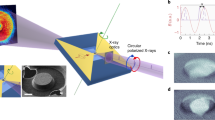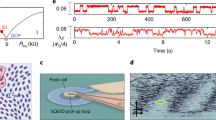Abstract
Strong magnetization fluctuations are expected near the thermodynamic critical point of a continuous magnetic phase transition. Such critical fluctuations are highly correlated and in principle can occur at any time and length scales1; they govern critical phenomena and potentially can drive new phases2,3. Although critical phenomena in magnetic materials have been studied using neutron scattering, magnetic a.c. susceptibility and other techniques4,5,6, direct real-time imaging of critical magnetization fluctuations remains elusive. Here we develop a fast and sensitive magneto-optical imaging microscope to achieve wide-field, real-time monitoring of critical magnetization fluctuations in single-layer ferromagnetic insulator CrBr3. We track the critical phenomena directly from the fluctuation correlations and observe both slowing-down dynamics and enhanced correlation length. Through real-time feedback control of the critical fluctuations, we further achieve switching of magnetic states solely by electrostatic gating. The ability to directly image and control critical fluctuations in 2D magnets opens up exciting opportunities to explore critical phenomena and develop applications in nanoscale engines and information science.




Similar content being viewed by others
Data availability
The data that support the findings of this study are available within the paper and its Supplementary Information. Additional data are available from the corresponding authors upon request.
References
Kardar, M. Statistical Physics of Fields (Cambridge Univ. Press, 2007).
Gibertini, M., Koperski, M., Morpurgo, A. F. & Novoselov, K. S. Magnetic 2D materials and heterostructures. Nat. Nanotechnol. 14, 408–419 (2019).
Burch, K. S., Mandrus, D. & Park, J. G. Magnetism in two-dimensional van der Waals materials. Nature 563, 47–52 (2018).
Dunlavy, M. J. & Venus, D. Critical slowing down in the two-dimensional Ising model measured using ferromagnetic ultrathin films. Phys. Rev. B. 71, 144406 (2005).
Djurberg, C. et al. Dynamics of an interacting particle system: evidence of critical slowing down. Phys. Rev. Lett. 79, 5154–5157 (1997).
Collins, M. F. Magnetic Critical Scattering (Oxford Univ. Press, 1989).
Huang, B. et al. Layer-dependent ferromagnetism in a van der Waals crystal down to the monolayer limit. Nature 546, 270–273 (2017).
Gong, C. et al. Discovery of intrinsic ferromagnetism in two-dimensional van der Waals crystals. Nature 546, 265–269 (2017).
Song, T. C. et al. Giant tunneling magnetoresistance in spin-filter van der Waals heterostructures. Science 360, 1214–1218 (2018).
Klein, D. R. et al. Probing magnetism in 2D van der Waals crystalline insulators via electron tunneling. Science 360, 1218–1222 (2018).
Deng, Y. J. et al. Gate-tunable room-temperature ferromagnetism in two-dimensional Fe3GeTe2. Nature 563, 94–99 (2018).
Huang, B. et al. Electrical control of 2D magnetism in bilayer CrI3. Nat. Nanotechnol. 13, 544–548 (2018).
Jiang, S. W., Li, L. Z., Wang, Z. F., Mak, K. F. & Shan, J. Controlling magnetism in 2D CrI3 by electrostatic doping. Nat. Nanotechnol. 13, 549–553 (2018).
Gong, C. & Zhang, X. Two-dimensional magnetic crystals and emergent heterostructure devices. Science 363, eaav4450 (2019).
Chen, L. B. et al. Topological spin excitations in honeycomb ferromagnet CrI3. Phys. Rev. X 8, 041028 (2018).
Sivadas, N., Okamoto, S., Xu, X. D., Fennie, C. J. & Xiao, D. Stacking-dependent magnetism in bilayer CrI3. Nano Lett. 18, 7658–7664 (2018).
Lado, J. L. & Fernandez-Rossier, J. On the origin of magnetic anisotropy in two dimensional CrI3. 2d Mater. 4, 035002 (2017).
Xu, C. S., Feng, J. S., Xiang, H. J. & Bellaiche, L. Interplay between Kitaev interaction and single ion anisotropy in ferromagnetic CrI3 and CrGeTe3 monolayers. NPJ Comput Mater. 4, 57 (2018).
Lee, I. et al. Fundamental spin interactions underlying the magnetic anisotropy in the Kitaev ferromagnet CrI3. Phys. Rev. Lett. 124, 017201 (2020).
Alsnielsen, J. & Birgeneau, R. J. Mean field-theory, Ginzburg criterion, and marginal dimensionality of phase-transitions. Am. J. Phys. 45, 554–560 (1977).
Mermin, N. D. & Wagner, H. Absence of ferromagnetism or antiferromagnetism in one- or 2-dimensional isotropic Heisenberg models. Phys. Rev. Lett. 17, 1133–1136 (1966).
Robinson, P. C. & Bradbury, S. Qualitative Polarized-Light Microscopy (Oxford Univ. Press, 1992).
Liu, K. H. et al. High-throughput optical imaging and spectroscopy of individual carbon nanotubes in devices. Nat. Nanotechnol. 8, 917–922 (2013).
Ho, J. T. & Litster, J. D. Divergences of magnetic properties of Crbr3 near critical point. J. Appl Phys. 40, 1270–1271 (1969).
Fisher, M. E. Renormalization group in theory of critical behavior. Rev. Mod. Phys. 46, 597–616 (1974).
Wilson, K. G. Renormalization group—critical phenomena and Kondo problem. Rev. Mod. Phys. 47, 773–840 (1975).
Giordano, N. J. Computational Physics 2nd edn (Pearson/Prentice Hall, 2006).
Kashuba, A. & Pokrovsky, V. L. Stripe domain-structures in a thin ferromagnetic film. Phys. Rev. Lett. 70, 3155–3158 (1993).
Portmann, O., Vaterlaus, A. & Pescia, D. An inverse transition of magnetic domain patterns in ultrathin films. Nature 422, 701–704 (2003).
Jia, D. D., Hamilton, J., Zaman, L. M. & Goonewardene, A. The time, size, viscosity, and temperature dependence of the Brownian motion of polystyrene microspheres. Am. J. Phys. 75, 111–115 (2007).
Wang, L. et al. One-dimensional electrical contact to a two-dimensional material. Science 342, 614–617 (2013).
Honerkamp-Smith, A. R., Veatch, S. L. & Keller, S. L. An introduction to critical points for biophysicists; observations of compositional heterogeneity in lipid membranes. BBA Biomembr. 1788, 53–63 (2009).
Zhang, J. et al. Discovery of slow magnetic fluctuations and critical slowing down in the pseudogap phase of YBa2Cu3Oy. Sci. Adv. 4, aao5235 (2018).
Acknowledgements
We thank J. Sethna and J. Kent-Dobias for discussions. This work was supported by the National Science Foundation (NSF) (grant no. DMR-1807810) for the development of the magneto-optical imaging microscope, the ARO Award no. W911NF-17-1-0605 for sample and device fabrication, the Cornell Center for Materials Research with funding from the NSF MRSEC programme (grant no. DMR-1719875) for optical characterizations and the Air Force Office of Scientific Research under award no. FA9550-19-1-0390 for data analysis. The growth of hBN crystals was supported by the Elemental Strategy Initiative of MEXT, Japan and CREST (grant no. JPMJCR15F3). K.F.M. acknowledges support from a David and Lucille Packard Fellowship. C.J. acknowledges support from a Kavli Postdoctoral Fellowship. Z.T. acknowledges support from the Watt W. Webb Graduate Fellowship in Nanoscience.
Author information
Authors and Affiliations
Contributions
C.J. conceived the experiment. C.J. and Z.T. developed the measurement technique and performed the experiment and analysis. Z.T. prepared the samples. K.K. fabricated the devices. K.W. and T.T. grew the bulk hBN crystals. C.J., K.F.M. and J.S. cowrote the manuscript. All authors discussed the results and commented on the manuscript.
Corresponding authors
Ethics declarations
Competing interests
The authors declare no competing interests.
Additional information
Publisher’s note Springer Nature remains neutral with regard to jurisdictional claims in published maps and institutional affiliations.
Supplementary information
Supplementary Information
Supplementary Notes 1–9 and Supplementary Figs. 1–7.
Supplementary Video 1
Real-time imaging of thin bulk CrBr3 at temperature of 28 K. The video was taken and shown both at 10 f.p.s.
Supplementary Video 2
Real-time imaging of monolayer CrBr3 S1 at temperature of 21.0 K. The video was taken at 70 f.p.s. and shown at 30 f.p.s.
Supplementary Video 3
Real-time imaging of monolayer CrBr3 S1 at temperature of 21.4 K. The video was taken at 70 f.p.s. and shown at 30 f.p.s.
Supplementary Video 4
Real-time imaging of monolayer CrBr3 S1 at temperature of 21.6 K. The video was taken at 70 f.p.s. and shown at 30 f.p.s.
Supplementary Video 5
Real-time imaging of monolayer CrBr3 S1 at temperature of 21.8 K. The video was taken at 70 f.p.s. and shown at 30 f.p.s.
Supplementary Video 6
Real-time imaging of monolayer CrBr3 S1 at temperature of 21.9 K. The video was taken at 70 f.p.s. and shown at 30 f.p.s.
Supplementary Video 7
Real-time imaging of monolayer CrBr3 S1 at temperature of 22.0 K. The video was taken at 70 f.p.s. and shown at 30 f.p.s.
Supplementary Video 8
Real-time imaging of monolayer CrBr3 S1 at temperature of 22.1 K. The video was taken at 70 f.p.s. and shown at 30 f.p.s.
Supplementary Video 9
Real-time imaging of monolayer CrBr3 S1 at temperature of 22.2 K. The video was taken at 70 f.p.s. and shown at 30 f.p.s.
Supplementary Video 10
Real-time imaging of monolayer CrBr3 S1 at temperature of 22.3 K. The video was taken at 70 f.p.s. and shown at 30 f.p.s.
Supplementary Video 11
Real-time imaging of monolayer CrBr3 S1 at temperature of 22.4 K. The video was taken at 70 f.p.s. and shown at 30 f.p.s.
Supplementary Video 12
Real-time imaging of monolayer CrBr3 S1 at temperature of 22.5 K. The video was taken at 70 f.p.s. and shown at 30 f.p.s.
Supplementary Video 13
Real-time imaging of monolayer CrBr3 S1 at temperature of 22.7 K. The video was taken at 70 f.p.s. and shown at 30 f.p.s.
Supplementary Video 14
Real-time imaging of magnetic switching in monolayer CrBr3 S1 by controlling the critical fluctuations with light. The video was taken and shown both at 10 f.p.s.
Rights and permissions
About this article
Cite this article
Jin, C., Tao, Z., Kang, K. et al. Imaging and control of critical fluctuations in two-dimensional magnets. Nat. Mater. 19, 1290–1294 (2020). https://doi.org/10.1038/s41563-020-0706-8
Received:
Accepted:
Published:
Issue Date:
DOI: https://doi.org/10.1038/s41563-020-0706-8
- Springer Nature Limited
This article is cited by
-
Thermal-activated escape of the bistable magnetic states in 2D Fe3GeTe2 near the critical point
Communications Physics (2023)
-
Electrically tunable magnetic fluctuations in multilayered vanadium-doped tungsten diselenide
Nature Electronics (2023)
-
Stripe phases in WSe2/WS2 moiré superlattices
Nature Materials (2021)
-
Magnetic domains and domain wall pinning in atomically thin CrBr3 revealed by nanoscale imaging
Nature Communications (2021)
-
Magnetization dependent tunneling conductance of ferromagnetic barriers
Nature Communications (2021)





